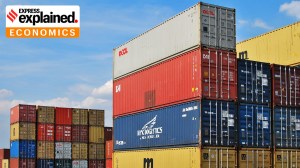- India
- International
G-7’s counter to China’s Belt and Road Initiative is welcome, but needs more coherence
It remains to be seen what role India will play in Build Back Better World since it has been a strong opponent of BRI, which is designed by China to establish strategic dominance in trade, foreign policy and geopolitics.
 Chinese construction workers walk together after work, in Colombo, Sri Lanka, June 3, 2018. (Adam Dean/The New York Times)
Chinese construction workers walk together after work, in Colombo, Sri Lanka, June 3, 2018. (Adam Dean/The New York Times)
G-7 leaders finally came around with the proposed Build Back Better World (B3W) to counter China’s rising influence across 100-plus countries through Belt Road Initiative (BRI) projects. The proposal, though at a nascent stage, aims to address the infrastructure investment deficit in developing and lower income countries — the space which has been increasingly captured by China through 2,600 BRI projects with trillions of dollars of investment. BRI projects are perceived as corrosive tactics or debt traps laid by China for its strategic dominance in trade, foreign policy and geopolitics in the world. So B3W is a welcome step but late.
The counter-strategy is necessary to bring down Chinese leverage. A macro view of BRI projects across geography — quantum and pattern of investment — clearly reflects the motive of China-centric international economic integration, production networks, hegemony in the Asia-Pacific region and, eventually, the global economy. Since the inception of the BRI in 2013, outward investment by Beijing has been aggressive as China’s FDI outflow to inflow ratio increased to 1 from around 0.34 during 2001-10. In volume terms, the FDI outflow increased to an average of $140 billion in 2016-19 from an annual average $25 billion during 2001-10. China’s share of FDI outflows increased from 2.3 per cent during 2001-10 to 10.7 per cent during 2016-2019.
China had an overall exposure of around $750 billion — $293 billion investment and $461 billion construction contracts —between 2013 to mid-2020. After BRI, there is a sudden increase in investment — around $40 billion annually during 2013-19 — in BRI countries, though investment has slowed down due to the pandemic. Since the onset of BRI, China has signed diverse projects worth $548.4 billion, including four-fifths in the BRI participating countries ($461 billion). Post 2013, there was a sudden rise in infrastructure investment in BRI projects compared to investment in non-BRI projects.
Since 2013 to mid-2020, China has an exposure of vast contracts worth around $123 billion in SSA, mainly with Nigeria, Zambia, Ethiopia, Angola, Tanzania and Kenya, mostly focusing on hydro and oil energy, shipping and rail transport. China has strategically made Kenya the African hub and plans to connect it with other land-locked countries in the region, including Uganda, South Sudan, Rwanda, etc.
Central, South and West Asia is China’s second preferred region under the BRI as construction contracts worth $110 billion are under way, and 80 per cent contracts are concentrated in Pakistan, Bangladesh, Russia, Iran and Kazakhstan. The China-Pakistan Economic Corridor (CPEC), the Bangladesh-China, India, the Myanmar Economic Corridor (BCIM) and the Colombo Port City Project in Sri Lanka, amongst others, are important BRI projects. China has a plan to complete 4,000 km of railways and 10,000 km of highways within the Central Asian region as part of BRI, with an estimated cost of $16 billion. Some of the major projects include freight trains between China, Turkey and Kazakhstan, and gas pipelines (Siberia and Altai) for production and transportation of oil and natural gas.

China has signed construction contracts worth around $96 billion under BRI, largely focusing on Saudi Arabia, UAE and Egypt, with 70 per cent allocation of total regional contract agreements. China is investing in Africa to lay a comprehensive transportation network.
 Since the launch of BRI, China has signed various contacts worth $90 billion with the East Asian region. The biggest contracts have been with Indonesia, Malaysia and Laos worth $18.5 billion, $17.1 billion and $11.2 billion respectively, mostly focusing on transportation, railways, roadways and waterways, for better integration between China and ASEAN countries.
Since the launch of BRI, China has signed various contacts worth $90 billion with the East Asian region. The biggest contracts have been with Indonesia, Malaysia and Laos worth $18.5 billion, $17.1 billion and $11.2 billion respectively, mostly focusing on transportation, railways, roadways and waterways, for better integration between China and ASEAN countries.
Since the onset of the BRI, the total exposure of China with Europe stood at around $23 billion by mid-2020. Major projects include a freight train project from Ukraine to Kazakhstan through Georgia, Azerbaijan, Kazakhstan and, eventually, China, covering a distance of 5,475 km. The Greek port Pireaus, the China-Belarus Industrial Park, and the Green Ecological Silk Road Investment Fund are other major projects. These initiatives would help trade facilitation for China and better delivery of goods and services.
The BRI projects broadly aim to facilitate cross-border transportation of goods, access to energy, creating demand for existing excess capacity in Chinese industries. Though the objectives of the projects undertaken in different countries vary, the overall focus is on developing transportation, logistics and communications, which would reduce trade and transaction cost for China’s trade, give more market access to Chinese markets and ensure stable supply of energy and other resources. Many countries, including India, would see an adverse trade impact on their products’ competitiveness, market access, resource extraction etc. due to Chinese competition.
China is focussed on its agenda and far ahead. It has also tried to rope in more countries and raised the acceptance level of BRI over time through the BRI summit, Boao Forum for Asia, China-Central and Eastern Europe (CEE), Belt and Road Forum, etc. The counter proposal of B3W is certainly a welcome step to contain the adverse implications of a Chinese mega plan. However, B3W lacks coherent thoughts and proper planning at this stage. Nevertheless, it is better late than never. Moreover, it remains to be seen what role India will play in B3W since it has been a strong opponent of China’s BRI.
This column first appeared in the print edition on July 17, 2021 under the title ‘A counter-strategy called B3W’. The writer is professor, Institute of Economic Growth (IEG), Delhi University.
40 Years Ago
EXPRESS OPINION
More Explained
Apr 18: Latest News
- 01
- 02
- 03
- 04
- 05









































